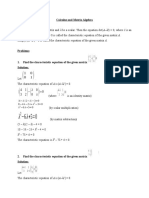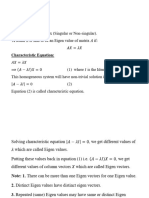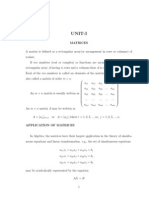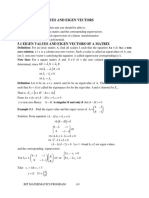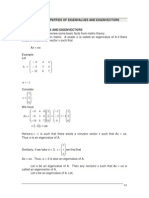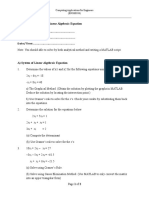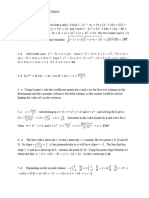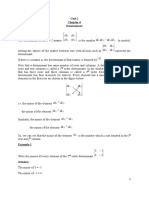0% found this document useful (0 votes)
59 views27 pages06 - Eigen Values and Eigen Vectors
The document discusses eigen values and eigen vectors. It defines eigen values as the roots of the characteristic equation of a matrix A. Eigenvectors are associated with each eigenvalue and satisfy the equation (A - λI)x = 0, where λ is the eigenvalue. The document outlines the steps to find eigenvalues and eigenvectors. It discusses three types of problems: 1) distinct eigenvalues with symmetric or non-symmetric matrices, 2) repeated eigenvalues with a non-symmetric matrix, and 3) repeated eigenvalues with a symmetric matrix. The document provides examples of finding eigenvalues and eigenvectors for matrices in each of the three categories. It concludes with an assignment involving four matrix problems of the different eigenvalue/eigenvector types.
Uploaded by
62Aniket VishwakarmaCopyright
© © All Rights Reserved
We take content rights seriously. If you suspect this is your content, claim it here.
Available Formats
Download as PPTX, PDF, TXT or read online on Scribd
0% found this document useful (0 votes)
59 views27 pages06 - Eigen Values and Eigen Vectors
The document discusses eigen values and eigen vectors. It defines eigen values as the roots of the characteristic equation of a matrix A. Eigenvectors are associated with each eigenvalue and satisfy the equation (A - λI)x = 0, where λ is the eigenvalue. The document outlines the steps to find eigenvalues and eigenvectors. It discusses three types of problems: 1) distinct eigenvalues with symmetric or non-symmetric matrices, 2) repeated eigenvalues with a non-symmetric matrix, and 3) repeated eigenvalues with a symmetric matrix. The document provides examples of finding eigenvalues and eigenvectors for matrices in each of the three categories. It concludes with an assignment involving four matrix problems of the different eigenvalue/eigenvector types.
Uploaded by
62Aniket VishwakarmaCopyright
© © All Rights Reserved
We take content rights seriously. If you suspect this is your content, claim it here.
Available Formats
Download as PPTX, PDF, TXT or read online on Scribd
/ 27













